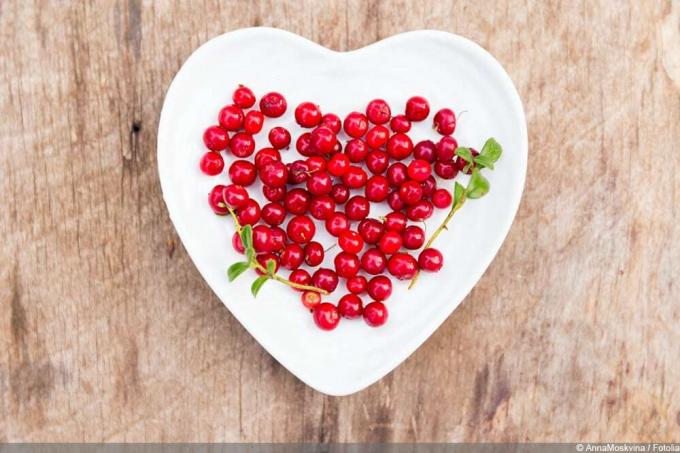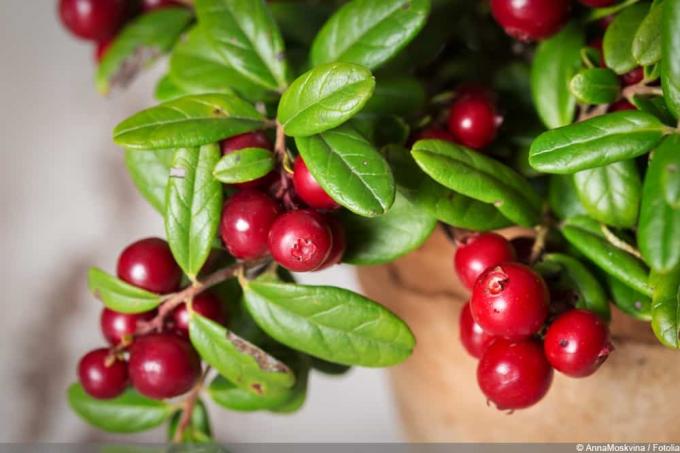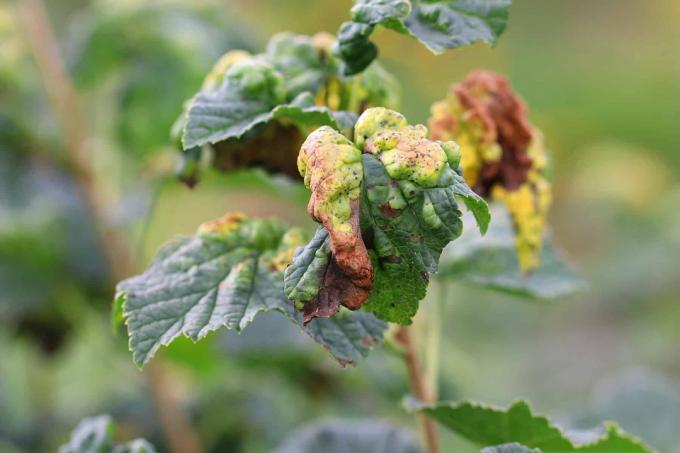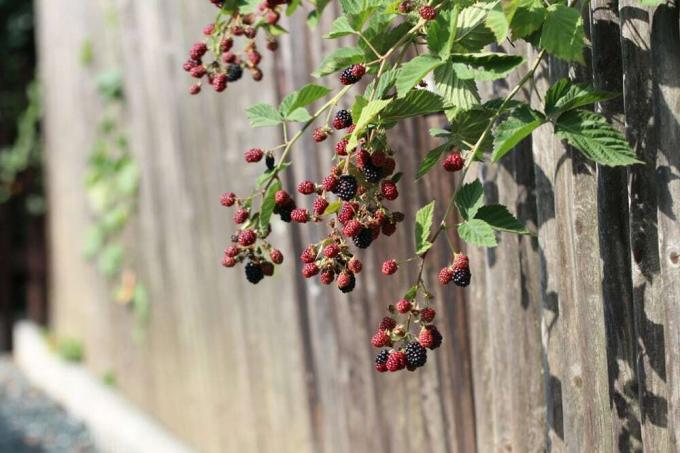

Table of contents
- species and origin
- appearance and growth
- Popular Varieties
- location and soil
- Plant
- tub culture
- Pour
- Fertilize
- Cut
- fertilization
- First fruits
- To harvest
- multiply
- hibernate
- Overwintering potted plants
- pests and diseases
Fresh berries from your own garden are a great thing. Just stretch out your hand and have a snack. It doesn't always have to be the berry representatives that are typical in this country. If you have enough space or are curious about something unusual, you can try cranberries. Also now widely known as cranberries. They thrive well and a lot can be conjured up from the harvest.
species and origin
In Germany, cranberry and crane berry are the actual names for this delicious berry from the heather family. In general usage, however, the word cranberry is becoming more and more popular, occasionally also in the German variant cranberry. Four types of cranberries are distinguished worldwide:
- Small-fruited cranberry
- Large fruited cranberry
- Southern cranberry
- and common cranberry
The natural range extends from Northern Europe, Russia to North America. It is primarily the large-fruited cranberry, native to eastern North America, that has found its way into our gardens as a high-yielding and easy-to-grow variety.
A notice:
In specialist shops, the cranberry is often also offered under the name cultured lingonberry.
appearance and growth
The pink and white bell-shaped blossom of the cranberry is reminiscent of a crane's head. This first gave the plant the name "crane berry" and later the name cranberry. The leaves are numerous, small, oval and green. They keep their green color all year round. Large-fruited cranberries form very long shoots that cover the ground as they creep. The fruits are about two centimeters long and one centimeter wide. They start out green in color and change to a bright red as they mature.
Popular Varieties

When selecting the variety, the climatic conditions in this country must be taken into account. Late frosts in particular are a real handicap and can destroy the harvest. Varieties whose fruits ripen late are therefore less suitable. Although this limits the choice considerably, some remain suitable early varieties left over. The most popular varieties are:
- bath
- Beckwith
- miner
- Black Veil
- McFarlin
- Searles
location and soil
The site requirements of the evergreen cranberry plant are usually not a problem in local gardens, because they only have conditions that are easy to fulfill:
- sunny to partially shaded place
- acidic environment with a pH of 4.0 to 5.0
- nutrient-poor and moderately moist soil
- the creeping growth is ideal as underplanting
- also suitable for flower boxes
- but then a partially shaded location
- acidic rhododendron soil is the ideal substrate
Tip:
The modest nutrient requirement here is to be taken literally. The flower suffers from an excessive supply of nutrients and thus causes a modest harvest.
Plant
Potted cranberry plants can be planted out in the garden in spring or autumn. Only frosty days are out of the question for planting. Due to their growth habit, cranberries are typical ground covers. If you have acquired a suitable plant, you can approach the planting as follows:
- Find a suitable place. It should be sunny to semi-shady. Cranberries are also suitable, for example, as underplanting for rhododendrons and fruit trees. Good neighbors are rhododendrons and blueberries.
- Dig a planting hole equal to the size of the root ball. Can also be a little larger.
- Loosen the soil and mix in some compost.
- Carefully remove the plant from its pot housing to avoid damaging it.
- Examine the root ball closely. Using sharp and clean secateurs, remove any damaged roots.
- Place the plant in the prepared planting hole and fill it with soil.
- Water the cranberries well.
- If you want to plant several plants, make sure they are spaced sufficiently apart. A distance of 30 cm from plant to plant is ideal. There should be no more than seven plants per square meter.
- Cover the ground around the plants with a layer of bark mulch or sawdust to prevent weeds from overgrowing the area that is initially free. This layer also keeps the soil evenly moist.
Tip:
For a rich harvest you should count on at least ten plants. For some sweet fruit in between and as a muesli supplement, one or a few copies are enough.
tub culture

A cranberry plant is also satisfied with a bucket. She likes to embed her roots in an acidic substrate such as B. rhododendron soil. Regular watering with lime-free water and a little fertilizer from time to time offer optimal growth conditions. No one has to do without delicious fruit, even when growing in tubs. If the care is right, even a bucket cranberry is not stingy with its fruity gifts. Make sure the pot size matches the size of the plant. If necessary, the plant should be transplanted into fresh substrate and a larger pot in spring. Regular use of scissors can also limit growth to an appropriate level.
Pour
The cranberry bush likes the soil to be evenly moist. Depending on the current weather, the watering can may have to provide this required moisture. However, the cranberry is also a tolerant plant: for a short time, it tolerates both dried-on soil and waterlogging.
- Rainwater is the ideal wet
- alternatively demineralised water
- keep evenly moist
- never let it dry out completely
- long waterlogging causes rot
- pot culture requires more water
A notice:
Cranberries are also thirsty in the cold season, especially when they are growing in pots. However, it may only be poured “modestly” on frost-free days.
Fertilize
For its part, the cranberry does not respond with gratitude to generous fertilizer gifts. The opposite is the case: the flowers stay out and so do the fruits.
- choose a nutrient-poor soil from the start
- only give some compost when planting
- do without fertilizer for outdoor specimens
- Only fertilize potted plants very sparingly
- a lime-free fertilizer is ideal
Cut
Regular pruning is not good for the health of the large-fruited cranberry. Vaccinium macrocarpon, still necessary for increasing crop yields. However, this plant is extremely keen to grow, which at some point makes the use of scissors unavoidable.
Over time, some old foothills die off and should be removed promptly.
- thin out regularly
- remove weak shoots after harvesting in autumn
- in autumn trim the edges as well
- then thin out generously in the spring
- Cut off overlapping rungs close to the ground
Tip:
Every three years, the cranberry plant should get a proper pruning for rejuvenation.
fertilization

Large-fruited cranberry plants are self-pollinating and produce edible fruit even as single plants. Nevertheless, there are advantages when several cranberries share the garden. The plants also pollinate each other. This social gathering therefore regularly leads to higher crop yields.
First fruits
Even if the shrub has accepted the offered garden realm and is thriving magnificently, it still takes years before it delivers the hoped-for fruit.
- bears the first fruits after about three years
- full profitability is achieved after five years
- Cranberries usually only bear very small fruits
- the large-fruited cranberry provides larger fruits (like gooseberries)
To harvest
Picking the berries is a bit time-consuming, as each individual berry has to be removed from the bush by hand. With a few berries, the effort is still manageable. However, if larger quantities have to be harvested, this can turn into work.
- Harvest months are September and October
- check harvest maturity beforehand
- is harvested by hand
Here's a simple way to check cranberry ripeness: Cut open a berry with a knife. If the flesh is still green, the berry is unripe. If it turns red, on the other hand, the harvest season can begin. If you like the sour-tart note, you can eat the fruit freshly picked as a snack. The small vitamin bombs also enrich fruit cakes, sweeten our breakfast as jam or go dried in the muesli box.
Tip:
The cranberries are far too delicious to let them rot on the bush. they contain valuable flavonoids, which are anti-inflammatory, and other valuable nutrients that support our immune system. If they stay on for any reason, they turn into winter ornaments. This decorative sight remains with us until spring.
multiply
When the amount of fruit harvested is less than the appetite, the time has come for cranberry regrowth. There are three options for propagation:
- Sowing seeds (including self-sowing)
- rooting of cuttings
- Division of the foothills
Sowing can be done from autumn up to and including winter. A cold frame is ideal for this. Cuttings, on the other hand, are taken from healthy shoots in summer and planted in potting soil.
A notice:
With targeted sowing and self-sowing, there is occasionally a risk of proliferation and ultimately the cranberry going wild.
hibernate

Cranberry plants are hardy and survive milder winters unscathed. However, their flowers and fruits are vulnerable to frost. If the temperature drops four degrees below zero, frostbite occurs. The flowers are affected in spring and the fruits in autumn. But no one has to bow to the frost and leave the cranberry unprotected.
- Fleece keeps frost at bay
- Cover/wrap the plant with it
Temperatures below seven degrees can seriously endanger more sensitive varieties. Even if protective measures have been taken. For this reason, care should be taken when selecting the variety, especially in harsh regions.
Overwintering potted plants
Potted plants should be given a sheltered location and a little extra attention.
- Pots need a sheltered place in winter
- a house wall is ideal
- temporarily move to a frost-free place during longer periods of cold weather
- otherwise the leaves will dry out
- water moderately even in winter
- but not on frosty days
Tip:
Even in a sheltered location, wrap the pots with plenty of plant protection fleece, because the soil in pots freezes through more quickly.
pests and diseases
In our latitudes, the crane berry is safe from pests and diseases. Chemical pesticides are completely superfluous in their cultivation. The red berries are allowed to ripen as a real organic treat. Yellow leaves are not a sign of disease, pests, or poor care. The cause is usually a very calcareous soil. In order not to increase the lime concentration, it should be poured with soft rainwater.
 Home editorial office
Home editorial office
Learn more about soft fruit

Leaf diseases on currants: leaf fall disease & Co
Diseases on the leaves are not uncommon in currants. They are triggered by fungi, viruses or various pests settle in. Many problems can be remedied with simple home remedies. Proper care also helps to prevent many diseases.

10 good neighbors of raspberries | mixed culture
Raspberries should grow healthily for several years and bring us a rich harvest every time. Choosing a good neighborhood helps to achieve this goal. But with whom does the berry plant like to share the bed and with whom not?

Honeyberry, Lonicera kamtschatica: 12 tips on location & care
In the local latitudes, the robust honeyberry can be cultivated and propagated well, as it does not make great demands on the site conditions and care measures. If you pay attention to certain factors when planting and cutting, you can already harvest sweet fruits in spring.

Cultivated blueberries: 4 important location criteria
The blueberry offers delicious fruits and is a visually appealing tree. However, the cultural form of the blueberry differs greatly from the demands on its location compared to its wild relatives. In the right location, cultivated blueberries can yield several kilos.

Blackberry location: 4 important criteria
Blackberries are a popular sweet fruit that is easy to care for. With a suitable location, plant health is guaranteed and the yield can be increased. The right location depends on the type of variety, because not every blackberry is insensitive to low temperatures.

Fighting lice on currants | 8 home remedies to get rid of aphids
When the first leaves appear on the currants in spring, there are often aphids on the bushes. The small insects are hidden under the leaves and can quickly cause a lot of damage. Therefore, lice should be combated at an early stage, ideally with natural home remedies.


